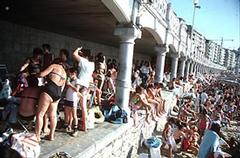Essay QuestionPUBLIC SPACESTHE PROPOSITION One civic institution under assault as the result of the seemingly inexorable blending of world cultures is the Public Space. This issue should be of particular interest to the architect since this is one arena in which building - "professionally" designed or not - has historically played a key role. Worldwide, Public Spaces have evolved over time, their origins in some cases nothing more than a crossing of well-traveled roads or the gathering of pilgrims about the shrine of a local deity or saint. Fostered by architecture, the result, ranging from a quiet town square, to a bustling marketplace, to the Agora in Athens, or the Zocalo in Mexico City, has played a key role in the everyday lives of individuals and their communities. Public Spaces are both concept and concrete. At their core, they are one of society's major achievements - the creation of places outside of the dwelling where, with impunity, the affairs fundamental to the well-being and emotional growth of the population are carried out for the good of all. Yet, Public Spaces are also complex and sophisticated physical creations. Architecturally, some were conceived of as unified works of design and building, while others have in fits and starts been added to and subtracted from for generations until a unified whole was achieved. Still other Public Spaces, not touched by architects, have achieved a fond place in the hearts of the populace. Though the history and architecture of a particular place may be of consequence to its appreciation by local people and visitors, what occurs there depends on each moment: who is present and their social agenda. It is important to recognize that the meaning and appreciation of a Public Space will be experienced differently by different people according to what they have come to expect when there. For example, a Public Space may be a market in the early hours of the morning. In the afternoon and evening, it is the setting for familial gatherings. But in the dark of the night, the Public Space can become a safe rendezvous for lovers. Today, many Public Spaces have lost their original character: dressed and themed to become major tourist attractions; gentrified and removed from the lives of all but a very few of the population; or replaced by rigidly and narrowly-defined shopping malls or districts that are controlled by anonymous faces. Most of these changes have been well-meaning attempts at town planning. The results, including segmentation of society, a reduction of spontaneity, and the substitution of spatial clarity for social "disorder" have often diminished rather then enhanced our everyday lives. In every locale, region, culture, there is a Public Space in danger of being overwhelmed and displaced in the 21st century. To appreciate how a remarkable Public Space and its buildings become a social entity through use, is the purpose of this year's Berkeley Prize Essay Question. THE QUESTIONWhat makes a place truly public? Go out into a community that you know well and find an exceptional, built example of one such place. In most likelihood, among other attributes, this place will embody the traditions of local culture and be a reflection of the world at large. Describe this place in a way that makes it a compelling demonstration of how other places might remain similarly vital to their own communities. Be both evocative and specific in your tribute to this place. Additional Help and InformationAre you in need of assistance? Please email info@berkeleyprize.org. |
|

